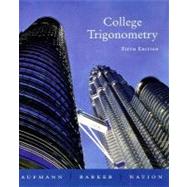
What is included with this book?
| Note: Each chapter concludes with a Summary, True/False Exercises, Review Exercises, and a Test. Chapters 2–7 include Cumulative Review Exercises | |
| Functions and Graphs | |
| Equations and Inequalities | |
| A Two-Dimensional Coordinate System and Graphs | |
| Introduction to Functions | |
| Properties of Graphs | |
| The Algebra of Functions | |
| Inverse Functions | |
| Modeling Data Using Regression | |
| Exploring Concepts with Technology: Graphing Piecewise Functions with a Graphing Calculator | |
| Trigonometric Functions | |
| Angles and Arcs | |
| Trigonometric Functions of Acute Angles | |
| Trigonometric Functions of Any Angle | |
| Trigonometric Functions of Real Numbers | |
| Graphs of the Sine and Cosine Functions | |
| Graphs of the Other Trigonometric Functions | |
| Graphing Techniques | |
| Harmonic Motion--An Application of the Sine and Cosine Functions | |
| Exploring Concepts with Technology: Sinusoidal Families | |
| Trigonometric Identities and Equations | |
| Verification of Trigonometric Identities | |
| Sum, Difference, and Cofunction Identities | |
| Double- and Half-Angle Identities | |
| Identities Involving the Sum of Trigonometric Functions | |
| Inverse Trigonometric Functions | |
| Trigonometric Equations | |
| Exploring Concepts with Technology: Approximate an Inverse Trigonometric Function with Polynomials | |
| Applications of Trigonometry | |
| The Law of Sines | |
| The Law of Cosines and Area | |
| Vectors | |
| Exploring Concepts with Technology: Optimal Branching of Arteries | |
| Complex Numbers | |
| Complex Numbers | |
| Trigonometric Form of Complex Numbers | |
| De Moivre's Theorem | |
| Exploring Concepts with Technology: The Mandelbrot Replacement Procedure | |
| Topics in Analytic Geometry | |
| Parabolas | |
| Ellipses | |
| Hyperbolas | |
| Rotation of Axes | |
| Introduction to Polar Coordinates | |
| Polar Equations of the Conics | |
| Parametric Equations | |
| Exploring Concepts with Technology: Using a Graphing Calculator to Find the nth Roots of z | |
| Exponential and Logarithmic Functions | |
| Exponential Functions and Their Applications | |
| Logarithmic Functions and Their Applications | |
| Logarithms and Logarithmic Scales | |
| Exponential and Logarithmic Equations | |
| Exponential Growth and Decay | |
| Modeling Data with Exponential and Logarithmic Functions | |
| Exploring Concepts with Technology: Using a Semilog Graph to Model Exponential Decay | |
| Solutions to the Try Exercises | |
| Answers to Selected Exercises | |
| Index | |
| Table of Contents provided by Publisher. All Rights Reserved. |
The New copy of this book will include any supplemental materials advertised. Please check the title of the book to determine if it should include any access cards, study guides, lab manuals, CDs, etc.
The Used, Rental and eBook copies of this book are not guaranteed to include any supplemental materials. Typically, only the book itself is included. This is true even if the title states it includes any access cards, study guides, lab manuals, CDs, etc.